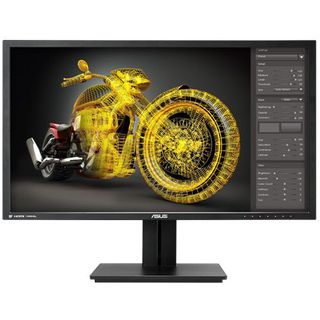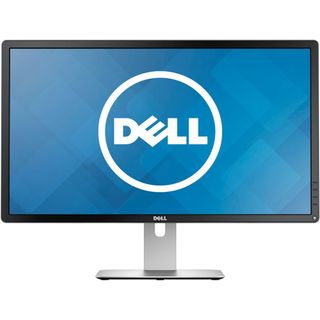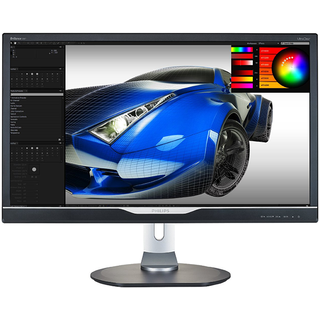Monoprice CrystalPro 28-Inch 4K Monitor Review
Nearly every monitor manufacturer has a 28-inch TN Ultra HD monitor in its line-up. Today we’re looking at Monoprice’s CrystalPro 4K. Even though it’s based on the same part as its competitors, you get quality that matches or exceeds those displays.
Why you can trust Tom's Hardware
Results: Brightness And Contrast
To read about our monitor tests in-depth, please check out Display Testing Explained: How We Test Monitors and TVs. Brightness and Contrast testing is covered on page two.
Uncalibrated – Maximum Backlight Level
The monitors in today’s comparison group are based on either the 2013 or 2014 version of Innolux’s UHD/TN 28-inch panel part. We know of no difference in spec between them, and our test results suggest no major changes were made from one year to the next.
Represented here are Samsung’s UD590, Asus’ PB287Q, Planar’s IX2850, Philips’ 288P6LJEB and Dell’s P2815Q.
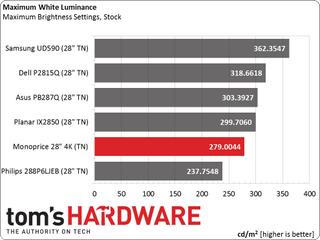
Samsung is the only company to rate its monitor at 370cd/m2 – a spec it nearly reaches. All of the others claim 300cd/m2. Monoprice doesn't quite reach that level, but it comes close. Turning on the Dynamic Contrast gets you a little more light (312.6731cd/m2, to be exact). However, that exacts a toll on gamma tracking and overall image quality.
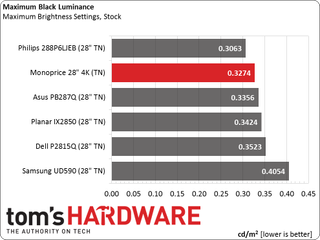
None of these Ultra HD displays sport great black levels. Monoprice comes close to the top position, though. Until VA panels make the jump to 4K resolution, we will likely see similar results for most high-res screens.
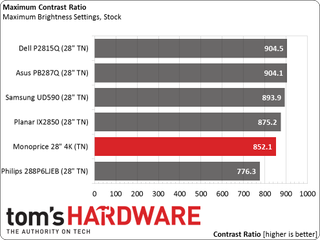
A result of 852.1 is middling in this group. Fortunately, thanks to clarity that’s a cut above, the image looks more contrasty to the naked eye. It’s a bit subjective, we realize. But using a clear front layer really enhances the CrystalPro 4K's look.
Uncalibrated – Minimum Backlight Level
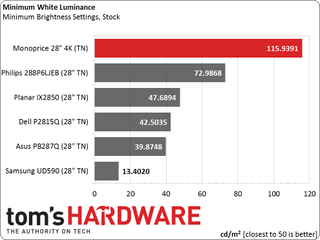
The backlight doesn’t go down far enough in our opinion. Many users prefer a dark-room setting of 80cd/m2 and we like 50cd/m2. With a 100-step backlight control, that means each click is worth about 1.6cd/m2. Planar comes closest to our preferred minimum brightness level.
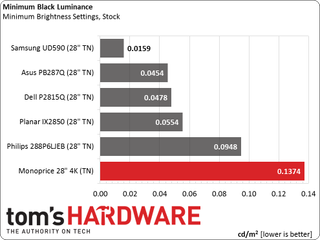
Due to the high brightness at Monoprice’s minimum setting, you can’t get a super-low black level.
We like lower output settings like this for gaming and movie-watching. Low levels mean that the black bars in cinemascope movies disappear, and games will look more three-dimensional.
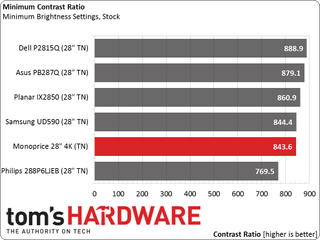
Contrast is at least consistent through the backlight control's entire range. Even though that range is smaller than we’d like, you still see the same image depth no matter what your brightness preference is.
After Calibration to 200cd/m2
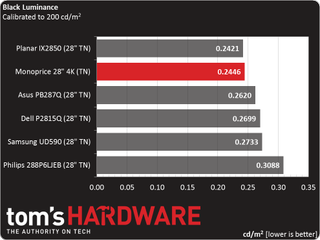
Calibration can often shuffle the field depending on how the white balance controls work. In Monoprice’s case, adjustment improves its black-level standing to a close second.
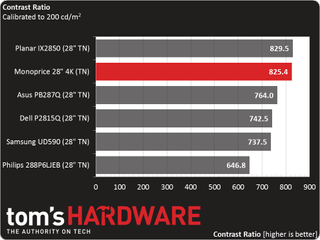
Contrast is reduced by only three percent after calibration. Few monitors can match that performance. There is essentially no penalty for adjusting the Monoprice to a high standard of color accuracy. All it takes are a few small tweaks of the RGB sliders.
ANSI Contrast Ratio
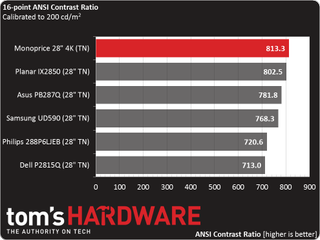
ANSI contrast remains solid at only a 1.5-percent reduction from the on/off number. It doesn’t get much better than this, folks. Excellent screen uniformity is partly responsible for such an excellent result. You’ll see just how good that is on page seven.
Current page: Results: Brightness And Contrast
Prev Page OSD Setup And Calibration Next Page Results: Grayscale Tracking And Gamma ResponseStay on the Cutting Edge
Join the experts who read Tom's Hardware for the inside track on enthusiast PC tech news — and have for over 25 years. We'll send breaking news and in-depth reviews of CPUs, GPUs, AI, maker hardware and more straight to your inbox.

Christian Eberle is a Contributing Editor for Tom's Hardware US. He's a veteran reviewer of A/V equipment, specializing in monitors. Christian began his obsession with tech when he built his first PC in 1991, a 286 running DOS 3.0 at a blazing 12MHz. In 2006, he undertook training from the Imaging Science Foundation in video calibration and testing and thus started a passion for precise imaging that persists to this day. He is also a professional musician with a degree from the New England Conservatory as a classical bassoonist which he used to good effect as a performer with the West Point Army Band from 1987 to 2013. He enjoys watching movies and listening to high-end audio in his custom-built home theater and can be seen riding trails near his home on a race-ready ICE VTX recumbent trike. Christian enjoys the endless summer in Florida where he lives with his wife and Chihuahua and plays with orchestras around the state.
-
cats_Paw 4k, 3d... next they will make a 5 something.Reply
THe market is not ready yet for that resolution, and the price is too high. -
milkod2001 Looking at Amazon link with price:$749 and other Amazon links for monitors from well established brands(cheaper) ,this Monoprice TN looks like bad attempt for joke.Reply
-
de5_Roy i wish it was IPS too!Reply
i also wish it was a 22-24" display. IMO woulda helped with viewing angle issues that plague TN-based monitors i.e. smaller size leads to less need for eye movement, sharper image from higher PPI. -
Karsten75 Your links are FUBAR. The link for the Asus PB287Q links to an AOC monitor. In any event, the price for the Asus PB287Q on Amazon is $612, NOT $399.Reply -
aberkae The price is $429 for this 4k monoprice monitor, thanks for the review you guys listen to requests much appreciated.Reply -
DisplayJunkie Wow, Monoprice FINALLY managed to produce a display which isn't completely useless like their previous products with no backlight/brightness control.Reply
Seems well built and the factory calibration is decent but $575 for TN, 60Hz...and most importantly and not surprisingly, only 850:1 contrast ratio (which Tom's calls "Good contrast" LOL).... as with all 4K TNs, all it has going for it is the high resolution. No other compelling reason to buy it, many other compelling reasons for other displays. -
aberkae Reply
they just had a sale that ended it was $429 I have the promo in my email, I'm expecting the price to fall again to that price15320841 said:Wow, Monoprice FINALLY managed to produce a display which isn't completely useless like their previous products with no backlight/brightness control.
Seems well built and the factory calibration is decent but $575 for TN, 60Hz...and most importantly and not surprisingly, only 850:1 contrast ratio (which Tom's calls "Good contrast" LOL).... as with all 4K TNs, all it has going for it is the high resolution. No other compelling reason to buy it, many other compelling reasons for other displays.
-
beshonk Where's the Benq XL2420G review? I'm debating on 4k, but whatever i buy will be G-sync for sure.Reply -
Chris Droste right now; today, 2/18 on AMAZON; this monitor is $750Reply
Dell P2815Q = $409
Samsung U28D590D = $529
both are UHD, HUNDREDs of dollars cheaper from brands with better reputations, and based on what Tom's knows about the panel it's all from the same Manufacturer, so...why get the Monoprice one again? adjustable stand for an extra $200 maybe? i don't get it...
